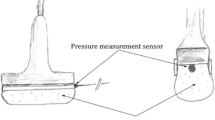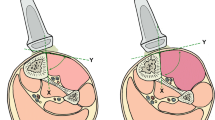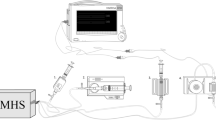Abstract
Purpose
There is a risk of misinterpreting the clinical signs of acute compartment syndrome of the lower limb resulting in delayed fasciotomy. Up to date, the diagnosis of compartment syndrome is based on clinical assessment and of invasive needle pressure measurement in uncertain cases. Close monitoring is necessary for early recognition of raising compartment pressures. Clinical assessment of muscle firmness by the physician’s palpation alone is unreliable. Thus, a device objectifying this assessment would be beneficial. The purpose of this study was to determine the feasibility of muscle compartment elasticity measurements by a novel and non-invasive device using pressure-related ultrasound.
Methods
In a cadaveric model, the anterior tibial compartment was prepared to simulate raising intra-compartmental pressures (0–80 mmHg) by saline infusion. Standard invasive pressure monitoring was compared with a novel method to determine tissue elasticity. Changing cross-sectional view in B-mode ultrasound was exerted to measure the compartment depth before and after physician’s probe compression of 100 mmHg. Compartment displacement (∆d) was measured and related to the corresponding compartmental pressure (Spearman correlation coefficient). Delta (mm) of the control group at 10 mmHg compartment pressure was compared with measured data at rising compartmental pressures of 30, 50, and 70 mmHg using the Wilcoxon rank-sum test. The intra-observer reliability (κ) was additionally calculated.
Results
Fresh and never frozen lower human limbs (n = 6) were used. The average displacement measured in the anterior tibial compartment was 2.7 mm (0.3–6.7 mm). A concordant consistent correlation between the compartmental displacement and the intra-compartmental pressure occurred. The Spearman coefficient (r s = 0.979) showed a significant correlation between the rising pressure and the decreasing tissue displacement visualized by ultrasound. The intra-observer value kappa showed reliable values (κ 10 = 0.73, κ 30 = 0.80, and κ 70 = 0.79).
Conclusions
We introduce a new method of ultrasound imaging enhanced with probe pressure measurement to determine changes of the visco-elastic behavior of isolated muscle compartments. Pressure-related ultrasound could be a reliable tool to determine the correlation between the measured compartmental displacement and the increasing intra-compartmental pressure. Its accuracy revealed promising results. This technique may help the physician to objectify the clinical assessment of compartment elasticity, mainly indicated in cases of unconscious patients and imminent pathology. Further clinical studies and improvements of this technique are required to prove its accuracy and reliability in cases of compartment syndrome.



Similar content being viewed by others
References
Mubarak SJ, Hargens AR. Acute compartment syndromes. Surg Clin North Am. 1983;63:539–65.
Heckman MM, Whiteside TE Jr, Grewe SR, et al. Histologic determination of the ischemic threshold of muscle in the canine compartment syndrome model. J Orthop Trauma. 1993;7:199–210.
Finkelstein J, Hunter G, Hu R, et al. Lower limb compartment syndrome: course after delayed fasciotomy. J Trauma. 1996;40:342–4.
McQueen MM, Christie J, Court-Brown CM. Acute compartment syndrome in tibial diaphyseal fractures. J Bone Joint Surg Br. 1996;78:95–8.
Rorabeck CH. The treatment of compartment syndrome of the leg. J Bone Joint Surg Br. 1984;66:93–7.
Oprel PP, Eversdijk MG, Vlot J, et al. The acute compartment syndrome of the lower leg: a difficult diagnosis? Open Orthop J. 2010;4:115–9.
Giannoudis PV, Nicolopoulos C, Dinopoulos H, et al. The impact of lower leg compartment syndrome on health related quality of life. Injury. 2002;33(2):117–21.
Shuler FD, Dietz MJ. Physicians’ ability to manually detect isolated elevations in leg intracompartmental Pressure. J Bone Joint Surg Am. 2010;92:361–7.
Prayson MJ, Chen JL, Hampers D, et al. Baseline compartment pressure measurements in isolated lower extremity fractures without clinical compartment syndrome. J Trauma. 2006;60:1037–40.
Ulmer T. The clinical diagnosis of compartment syndrome of the lower leg: are clinical findings predictive of the disorder? J Orthop Trauma. 2002;16:572–7.
Shadgan B, Menon M., O’Brien PJ, et al. Diagnostic techniques in acute compartment syndrome of the leg. J Orthop Trauma. 2008; 22:581–587.
Al-Dadah OQ, Darrah C, Cooper A, et al. Continuous compartment pressure monitoring vs. clinical monitoring in tibial diaphyseal fractures. Injury. 2008;39:1204–9.
Shadgan B, Menon M, Sanders D, et al. Current thinking about acute compartment syndrome of the lower extremity. Can J Surg. 2010;53:329–34.
Ramana YV, Krishna GG, Khadeer MA. Shear velocity of muscle tissue. J Biomed Eng. 1980;2:211–5.
Aaron R, Huang M, Shiffman CA. Anisotropy of human muscle via non-invasive impedance measurements. Phys Med Biol. 1997;42:1245–62.
Murayama G, Nosaka K, Yoneda T, et al. Changes in stiffness of the human elbow flexor muscles after eccentric exercise. Eur J Appl Physiol. 2000;82:361–7.
Arokoski JPA, Srakka J, Ojala T, et al. Feasibility of the use of a novel soft tissue stiffness meter. Physiol Meas. 2005;26:215–28.
Steinberg BD, Gelberman RH. Evaluation of limb compartments with suspected increased interstitial pressure. A non-invasive method for determining quantitative stiffness. Clin Orthop Relat Res. 1994;300:248–53.
Steinberg BD. Evaluation of limb compartments with increased interstitial pressure. An improved noninvasive method for determining quantitative hardness. J Biomech. 2005;38:1629–35.
Ophir J, C’espedes I, Ponnekanti H, et al. Elastography: a quantitative method for imaging the elasticity of biological tissue. Ultrason Imaging. 1991;13:111–34.
C’espedes I, Ophir J, Ponnekanti H, et al. Elastography: elasticity imaging using ultrasound with application to muscle and breast in vivo. Ultrason Imaging. 1993;15:73–88.
Gennisson JL, Cornu C, Cathline S, et al. Human muscle hardness assessment during incremental isometric contraction using transient elastography. J Biomech. 2005;38:1543–50.
Kimura K, Watanabe Y, Umeda M, et al. Quantitative analysis of the relation between soft tissue stiffness palpated from the body surface and tissue hemodynamic in the human forearm. Physiol Meas. 2007;28:1495–505.
Gershuni DH, Gosink BB, Hargens AR, et al. Ultrasound evaluation of the anterior musculofascial compartment of the leg following exercise. Clin Orthop Rel Res. 1982;167:185–90.
Acknowledgments
This investigation and research project was supported by the START-Program of the faculty of medicine, RWTH Aachen University, Germany.
Conflict of interest
R. M. Sellei, S. J. Hingmann, C. Weber, S. Jeromin, F. Zimmermann, J. Turner, F. Hildebrand and H.-C. Pape disclose all possible conflicts of interest in the manuscript, including financial, consultant, institutional and other relationships that might lead to bias or a conflict of interest.
Ethical standards
This study has been performed in accordance with the ethical standards laid down in the 1964 Declaration of Helsinki. The authors gave their informed consent prior to their inclusion in the study.
Author information
Authors and Affiliations
Corresponding author
Rights and permissions
About this article
Cite this article
Sellei, R.M., Hingmann, S.J., Weber, C. et al. Assessment of elevated compartment pressures by pressure-related ultrasound: a cadaveric model. Eur J Trauma Emerg Surg 41, 639–645 (2015). https://doi.org/10.1007/s00068-014-0449-9
Received:
Accepted:
Published:
Issue Date:
DOI: https://doi.org/10.1007/s00068-014-0449-9




